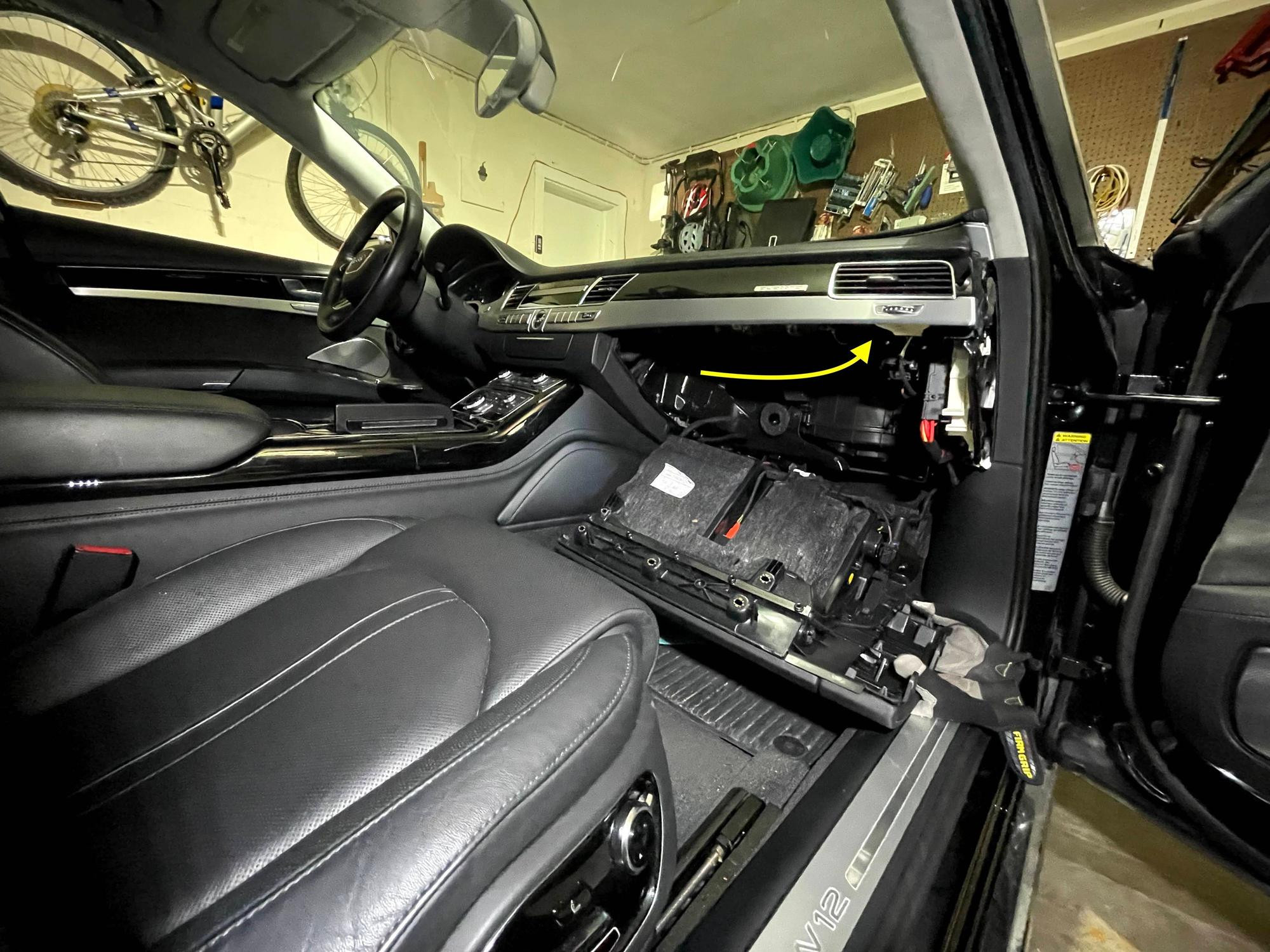
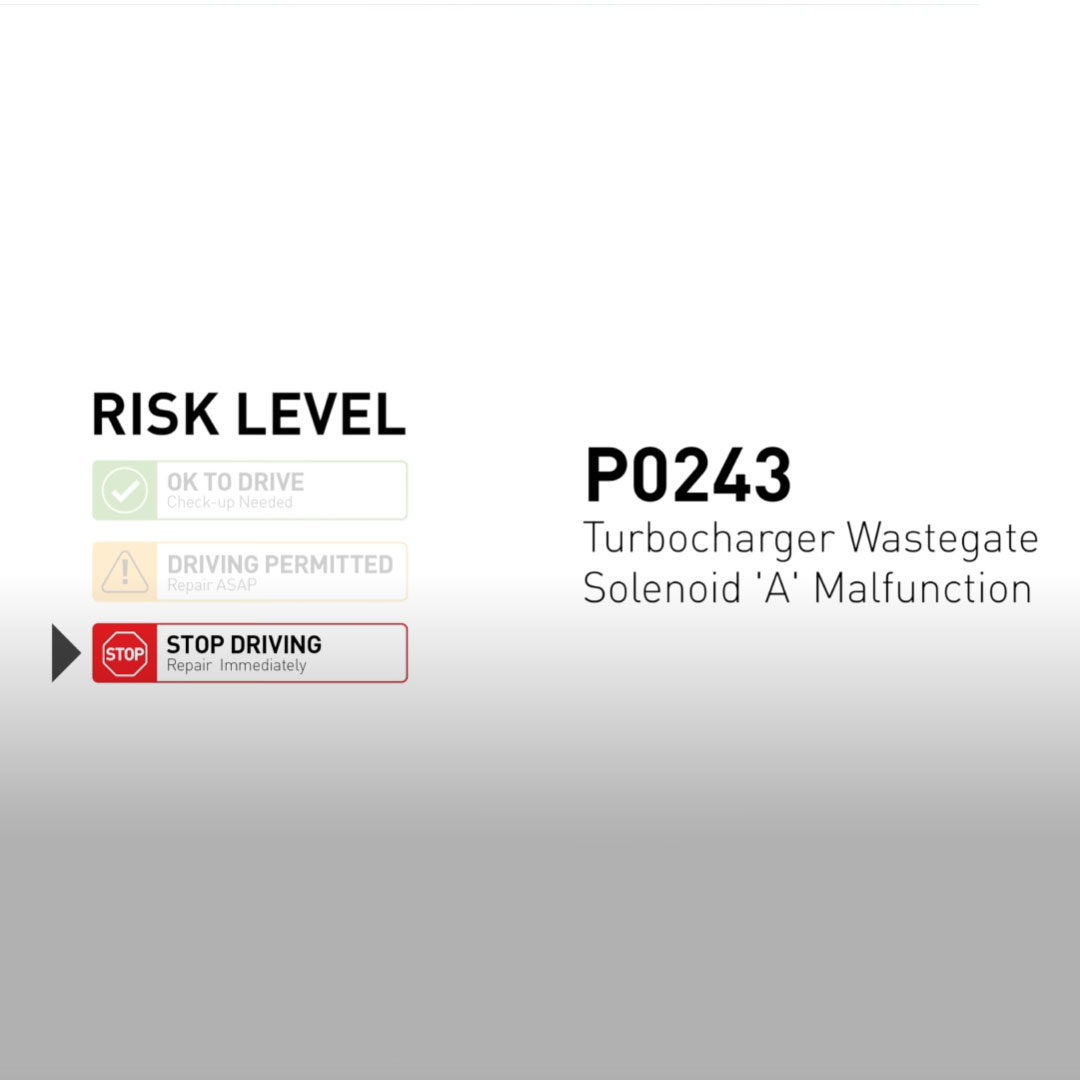
DTC P0243 Audi Turbocharger Wastegate Solenoid A – Causes, Symptoms, and Fixes
Contents
- 1. What is DTC P0243 Audi?
- 1.1. How Does the Turbocharger Wastegate Solenoid Work?
- 1.2. Common Symptoms of a P0243 Code in Audi Vehicles
- 2. Potential Causes of the P0243 Code in Audi Vehicles
- 2.1. Faulty N75 Boost Pressure Control Solenoid Valve
- 2.2. Damaged or Leaking Vacuum Hoses
- 2.3. Wiring Issues or Electrical Short
- 2.4. ECU (Engine Control Unit) Signal Fault
- 2.5. Aftermarket Modifications or Overboost Tuning
- 3. Tools and Software Needed to Diagnose and Repair the P0243 Error
- 3.1. Tools:
- 3.2. Software:
- 4. How to Fix DTC P0243 on VW/Audi Vehicles
- Step 1: Connect the Diagnostic Tool and Confirm the Fault Code
- Step 2: Inspect and Test the N75 Valve Functionality
- Step 3: Inspect Vacuum Lines and System Integrity
- Step 4: Replace the N75 Valve If Necessary
- Step 5: Clear Fault Codes and Perform Road Test
- 5. How Much Does Fixing Audi P0243 Error Cost?
- 5.1. Diagnostic Fee
- 5.2. N75 Valve Replacement (Boost Pressure Control Solenoid)
- 5.3. Vacuum Line Repair or Replacement
- 5.4. Turbo Wastegate Actuator Repair or Replacement
- 5.5. Wiring or ECU Issue
- Average Repair Cost Range
- Tips to Save Money
- 6. Tips for Preventing Future Issues
- 6.1. Perform Regular Turbocharger System Inspections
- 6.2. Keep the N75 Valve Clean and Functional
- 6.3. Avoid Aggressive Driving on a Cold Engine
- 6.4. Use High-Quality Engine Oil and Replace It Regularly
- 6.5. Ensure Proper Software and ECU Updates
- 6.6. Use a Boost Gauge or OBD Monitor for Early Detection
- 6.7. Don’t Ignore Minor Boost-Related Symptoms
- Need Help Fixing Audi P0243? Let AutoExplain Handle It!
If you’re seeing the dreaded Dtc P0243 Audi code pop up on your scanner, you’re not alone. This fault is fairly common in turbocharged Audi vehicles, and if not fixed promptly, it can impact performance, fuel economy, and even lead to long-term turbocharger damage.
In this comprehensive guide, we’ll walk you through everything you need to know about the Audi P0243 code: what it means, why it happens, how to diagnose it, and most importantly—how to fix it like a pro, even if you’re not a master technician.
1. What is DTC P0243 Audi?
The P0243 code, specifically in Audi vehicles, indicates a malfunction in the “A” circuit of the turbocharger wastegate solenoid. This solenoid is crucial for controlling the turbocharger’s boost pressure, ensuring optimal engine performance. When the Powertrain Control Module (PCM) detects an electrical issue within this circuit, it triggers the P0243 code. According to a study by the ASE (Automotive Service Excellence), correctly diagnosing such issues can improve engine efficiency by up to 15%. This highlights the importance of understanding and addressing this code promptly.
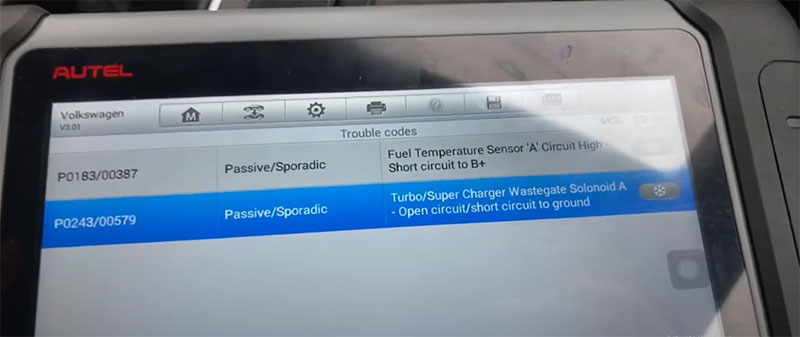
1.1. How Does the Turbocharger Wastegate Solenoid Work?
The turbocharger wastegate solenoid regulates the amount of exhaust gas that bypasses the turbine in a turbocharged engine. By controlling this bypass, it manages the boost pressure, preventing overboost conditions that can damage the engine. The solenoid receives signals from the PCM, which monitors various engine parameters to determine the appropriate boost level. A malfunctioning solenoid can lead to either underboost or overboost, both of which negatively affect engine performance and longevity.
1.2. Common Symptoms of a P0243 Code in Audi Vehicles
When your Audi displays a P0243 code, you might experience several noticeable symptoms:
- Reduced Engine Power: The most immediate symptom is often a significant decrease in engine power and acceleration.
- Check Engine Light: The Malfunction Indicator Light (MIL) on your dashboard will illuminate, signaling a problem.
- Erratic Boost Pressure: The turbocharger might produce inconsistent or unpredictable boost levels.
- Audible Turbocharger Issues: Unusual noises from the turbocharger, such as whistling or whining, can occur.
2. Potential Causes of the P0243 Code in Audi Vehicles
2.1. Faulty N75 Boost Pressure Control Solenoid Valve
The N75 valve is an electrically controlled solenoid that regulates boost by controlling vacuum to the wastegate actuator. If this valve is defective, it cannot properly route vacuum pressure, leading to incorrect turbo boost levels.
Failure scenarios include:
-
Internal electrical failure: Burned or broken coil windings inside the solenoid.
-
Mechanical jamming: The internal plunger or valve may get stuck due to oil vapor, carbon build-up, or debris.
-
Intermittent operation: Sometimes works, sometimes doesn’t, depending on temperature or vibration.
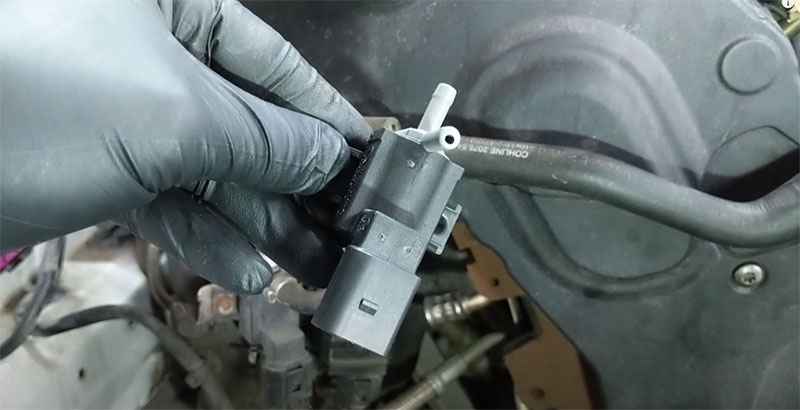
*Test Tip: A healthy N75 valve typically has a resistance between 15–35 Ohms. Outside this range suggests internal failure.
2.2. Damaged or Leaking Vacuum Hoses
The N75 valve connects to several vacuum lines that route pressure to the turbo actuator. If any of these lines are cracked, collapsed, disconnected, or leaking, the N75 cannot build or release pressure properly.
Look out for:
-
Brittle hoses (common in high-mileage or older Audi models)
-
Loose clamps or disconnected lines
-
Oil-saturated hoses causing soft spots or internal collapse
*Pro Tip: Use a handheld vacuum pump to check if the system holds vacuum pressure. If it leaks down quickly, one of the hoses or fittings is at fault.
2.3. Wiring Issues or Electrical Short
The N75 valve receives a control signal from the ECU via a two-pin connector. If the wiring harness is damaged, corroded, or incorrectly grounded, the valve won’t actuate as commanded.
Potential problems include:
-
Broken or frayed wires near engine heat zones
-
Corroded connectors from water ingress or road salt
-
Open circuit (wire disconnected or internally broken)
-
Short to ground or short to power (triggers immediate DTC P0243 Audi)
*Diagnostic Tip: Perform a continuity and voltage drop test on both wires between the ECU and N75. Use wiring diagrams from ElsaWin if needed.
2.4. ECU (Engine Control Unit) Signal Fault
Although rare, the root cause of P0243 Audi can originate from the ECU itself. If the ECU’s internal driver circuit responsible for activating the N75 is damaged or overloaded (possibly due to aftermarket tuning), the solenoid will not function even if everything else is in perfect condition.
This can happen due to:
-
Incorrect ECU remapping or boost pressure tuning
-
Voltage spikes or improper grounding
-
Software bugs from poor-quality tune files
*Important Note: If a known-good N75 and wiring still result in P0243, consider reflashing or replacing the ECU. Always use OEM or certified tuning solutions.
2.5. Aftermarket Modifications or Overboost Tuning
Audi vehicles with performance modifications (intake, ECU remaps, aftermarket turbos) are more prone to overboost conditions, which can place excess stress on the N75 control system.
Common mistakes:
- Disabling boost limiters via ECU tuning without properly recalibrating the N75 response
- Installing manual boost controllers that bypass factory solenoids
- Failing to properly vent crankcase pressure, leading to oil in the vacuum system
3. Tools and Software Needed to Diagnose and Repair the P0243 Error
Before diving into diagnostics, you’ll need proper tools and software:
3.1. Tools:
- OBD-II Diagnostic Scanner: VCDS (VAG-COM), Launch X431, or ODIS for reading fault codes and live data.
- Multimeter: For checking voltage, resistance, and continuity.
- Vacuum Pump Tester: To inspect vacuum line integrity.
- Basic Hand Tools: Screwdrivers, pliers, sockets for component removal.
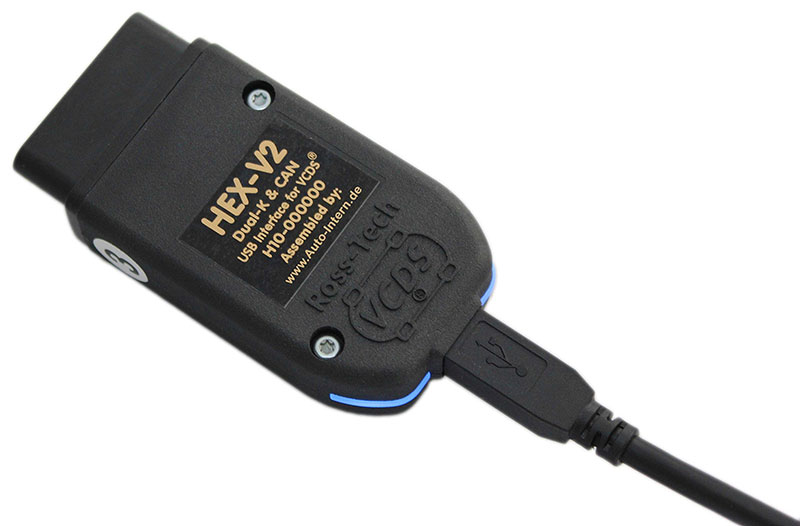
3.2. Software:
- VCDS (VAG-COM Diagnostic System): For Audi-specific diagnostics, test activation, and live boost data monitoring.
- ODIS: For dealer-level diagnosis, coding, and turbo calibration.
- ElsaWin: Optional, for reference to wiring diagrams and service procedures.
4. How to Fix DTC P0243 on VW/Audi Vehicles
Resolving the P0243 Audi or VW fault code requires a structured diagnostic and repair approach. Below is a detailed guide that walks you through each step to identify and fix the root cause of this boost pressure control solenoid (N75) malfunction.
Step 1: Connect the Diagnostic Tool and Confirm the Fault Code
- Plug your OBD-II diagnostic tool (such as VCDS, ODIS, or Launch X431) into the OBD-II port under the dashboard.
- Turn on the ignition and scan the vehicle for stored fault codes.
- Confirm that DTC P0243 is present in the engine control module (ECM).
- Go to Live Data and monitor the status of the N75 valve (Boost Pressure Control Solenoid) while gradually increasing the throttle. Observe whether the valve responds (duty cycle percentage or activation signal changes).
- If multiple turbo-related DTCs are detected (e.g., P0299, P2261), prioritize resolving them in a logical sequence—starting with electrical or control faults first.
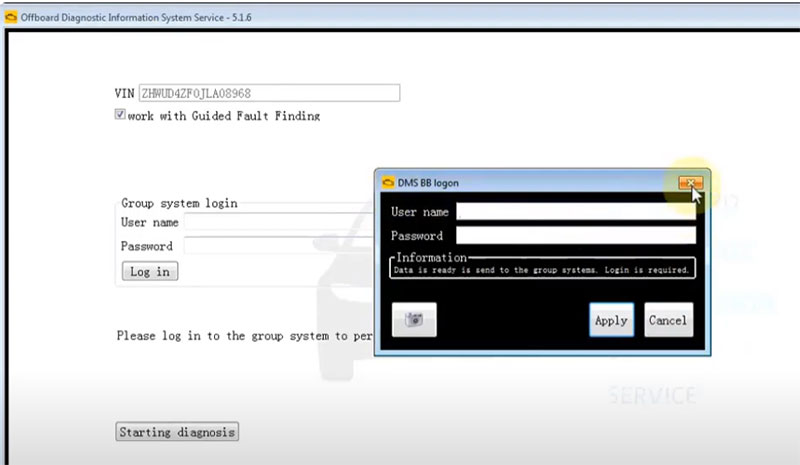
Some Error Code May Accompany P0243 Audi
-
Audi DTC P0234 – Turbocharger Overboost Condition
-
Often triggered when the wastegate fails to open properly (e.g., stuck closed due to a faulty N75 valve).
-
-
Audi DTC P0299 – Turbo/Supercharger Underboost
-
May occur if the wastegate is stuck open or the N75 valve is not allowing proper boost regulation.
-
-
Audi DTC P0245 – Turbocharger Wastegate Solenoid “A” Low
-
Similar to P0243, but specifically indicates a low voltage issue in the control circuit.
-
-
Audi DTC P0246 – Turbocharger Wastegate Solenoid “A” High
-
Indicates an open circuit or voltage too high to the solenoid, another electrical fault variant of P0243.
-
-
Audi DTC P2261 – Turbocharger Bypass Valve – Mechanical
-
May occur in conjunction if the turbo pressure control system is malfunctioning.
-
-
Audi DTC P2262 – Turbo Boost Pressure Not Detected – Mechanical
-
Indicates the ECM is not detecting boost, potentially due to a bad N75 valve or vacuum leak.
-
-
Audi DTC P0033 – Turbocharger Bypass Valve Control Circuit
-
Sometimes related if the bypass valve shares similar control logic or wiring with the N75.
-
-
Audi DTC P0101 – MAF Sensor Range/Performance
-
Faulty mass airflow readings can affect boost control and indirectly cause P0243-related symptoms.
-
-
Audi DTC P0401 – Exhaust Gas Recirculation Flow Insufficient–
-
Although EGR-related, can appear in parallel due to shared vacuum or sensor interactions.
-
*Tip: Recording freeze frame data when the fault was triggered can provide helpful context for diagnosing intermittent issues.
Step 2: Inspect and Test the N75 Valve Functionality
The N75 valve—also known as the turbocharger boost control solenoid—is critical in managing the opening and closing of the wastegate. When DTC P0243 appears, one of the most common culprits is a faulty or sticking N75 valve. Here’s how to properly inspect and test it:
2.1 Locate the N75 Valve
- In most Audi turbocharged engines, the N75 valve is mounted near the turbocharger, usually along the firewall or on a bracket near the intake manifold.
- It will have three vacuum hose ports and an electrical connector, and is typically labeled or connected with color-coded hoses.
2.2 Perform a Visual Inspection
- Check vacuum hoses for cracks, brittleness, or loose connections.
- Inspect the electrical connector and wiring harness for signs of corrosion, exposed wires, or broken pins.
- Ensure the valve itself isn’t contaminated with oil or dirt, which can affect its movement.
2.3 Bench Test the N75 Valve (Using a Multimeter and Power Source)
- Electrical test:
- Disconnect the electrical connector.
- Using a multimeter, check resistance across the terminals.
- Normal resistance values typically range from 25 to 35 ohms (check your specific Audi model’s repair manual for exact specs).
- If the resistance is out of range (infinite or 0), the solenoid is faulty.
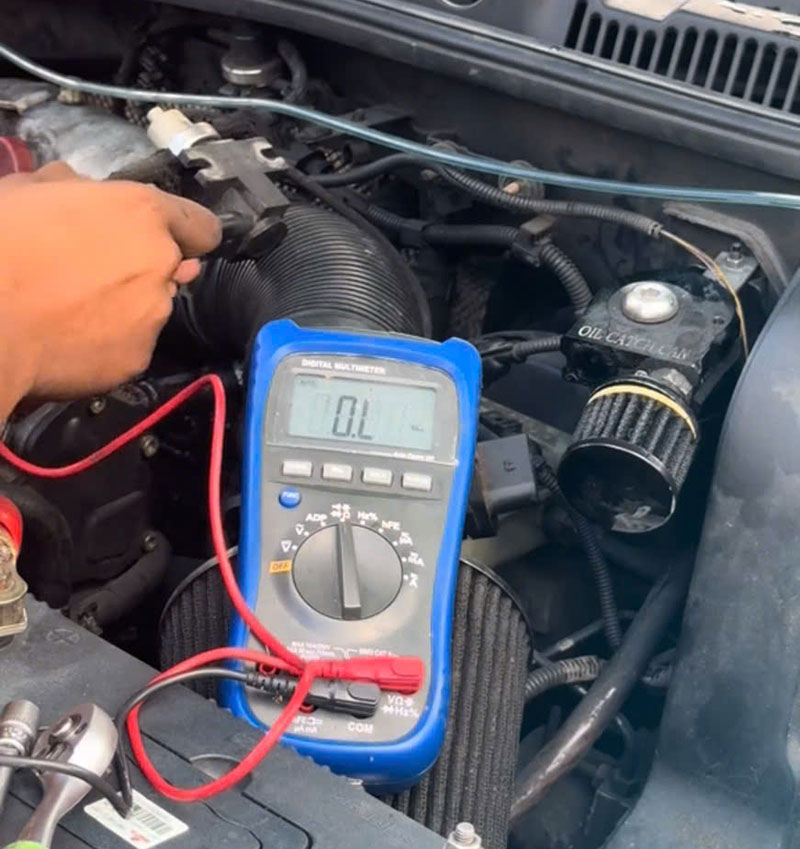
- Activation test with power:
- Apply 12V power directly to the solenoid pins using jumper wires.
- Listen for a distinct clicking sound, indicating the solenoid is functioning.
- If no click is heard, the valve may be stuck or internally damaged.
2.4 Vacuum Flow Test (Optional but Ideal)
- With the N75 valve removed, use a hand-held vacuum pump:
- Apply vacuum to one port and watch to see if the valve correctly redirects flow when energized.
- The valve should block or redirect vacuum depending on whether it’s powered on or off.
- A failure to hold or redirect vacuum means the valve is defective.
Result:
-
If the N75 valve fails any of these tests, it should be replaced.
-
If it passes, move to the next diagnostic step, as the issue may lie with the ECU control signal, wiring, or wastegate actuator itself.
*Caution: Only apply direct voltage for short periods, and double-check polarity and specs before testing.
Step 3: Inspect Vacuum Lines and System Integrity
A malfunctioning vacuum system is a common root cause of DTC P0243 on Audi vehicles, especially in turbocharged engines that rely on precise vacuum control to operate components like the wastegate actuator and N75 valve. Even a small vacuum leak or collapsed hose can cause underboost or control signal failure.
Here’s how to carefully inspect the vacuum lines and ensure system integrity:
3.1 Understand the Vacuum Circuit
Before inspection, it’s essential to understand the basic layout:
-
The vacuum system includes: the intake manifold vacuum source, hoses to the N75 valve, the wastegate actuator, check valves, and any vacuum reservoirs.
-
A fault in any part of this path can disrupt the correct operation of boost control.
3.2 Perform a Thorough Visual Inspection
-
Check all rubber and plastic vacuum hoses connected to the N75 valve and wastegate actuator.
-
Look for:
-
Cracks
-
Hardening or brittleness
-
Loose or disconnected ends
-
Oil contamination (which may soften or degrade hoses)
-
-
Don’t forget hidden lines routed under the intake manifold or heat shields.
Pro Tip: Slightly bend the hoses along their length. Cracks may open up that are otherwise invisible when the hose is straight.
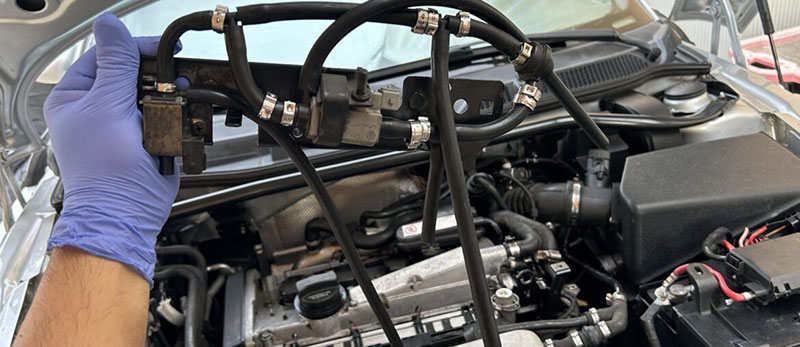
3.3 Test for Vacuum Leaks (Using Tools)
To ensure the system is sealed and functioning, perform a vacuum leak test:
Option 1: Handheld Vacuum Pump Test
-
Disconnect the vacuum line from the N75 or wastegate actuator.
-
Connect a handheld vacuum pump to each line individually.
-
Pump to build vacuum (~15–20 inHg) and observe the gauge.
-
If the vacuum drops quickly, there’s a leak somewhere in that section.
Option 2: Smoke Test
-
Introduce smoke into the vacuum lines using a smoke machine.
-
Observe for visible smoke leaks near hose ends, cracks, or plastic fittings.
-
This method is highly effective for locating micro leaks that aren’t visible or audible.
3.4 Inspect Check Valves and Vacuum Reservoirs
-
Check any one-way check valves in the system:
-
Blow through both ends — air should only pass in one direction.
-
If air passes both ways, the check valve has failed and needs replacement.
-
-
Vacuum reservoirs (typically plastic canisters) should hold vacuum when tested. A cracked or leaking reservoir can reduce system efficiency.
Result
If any hoses are found leaking, cracked, or collapsing under vacuum, replace them with high-quality vacuum-rated hose of the correct diameter. Do not use fuel lines or generic tubing, as they may collapse under engine vacuum or heat.
Once the vacuum system is verified leak-free and functioning, clear DTCs and test drive to check if the P0243 code returns. If it does, proceed to check the wastegate actuator or ECU control signal in the next steps.
Step 4: Replace the N75 Valve If Necessary
If your testing in Step 2 confirmed that the N75 valve is malfunctioning — whether it’s electrically faulty, stuck open/closed, or not regulating boost properly — then replacement is the logical next step. A faulty N75 can directly trigger DTC P0243, causing underboost, limp mode, or improper turbo control.
Here’s how to replace it safely and correctly:
4.1 Identify the Correct N75 Valve for Your Engine
Before replacement, ensure you’re ordering the correct OEM or high-quality aftermarket part. The N75 valve part number may vary slightly between Audi models and engine types (e.g., 1.8T, 2.0T, 2.7T, etc.).
-
Check your current valve for its part number.
-
Cross-reference it using your VIN in ETKA, Audi EPC, or a trusted parts catalog.
-
Avoid cheap generic replacements — poor-quality valves can cause inconsistent boost behavior or fail prematurely.
4.2 Gather Required Tools
-
Flathead screwdriver or hose clamp pliers
-
Torx or socket set (depending on mounting hardware)
-
Needle-nose pliers (for spring clips)
-
Clean rag and some vacuum-safe grease (optional)
4.3 Step-by-Step N75 Valve Replacement
-
Disconnect Battery (Optional but Recommended)
While not mandatory, disconnecting the battery ensures safety during handling of electronic components. -
Locate the N75 Valve
It’s usually mounted near the turbocharger, firewall, or air intake piping and has:-
One electrical connector
-
Three vacuum hose ports (labeled ‘IN’, ‘OUT’, and ‘VENT’)
-
-
Label and Remove Vacuum Hoses
-
Use masking tape or take a picture before removal to avoid incorrect reinstallation.
-
Gently twist and pull vacuum lines off. If they’re stuck, use a little penetrating oil or heat.
-
-
Disconnect the Electrical Connector
-
Press the release tab and pull the connector away from the valve.
-
Inspect the connector pins for corrosion or looseness.
-
-
Remove the Valve from Its Bracket
-
Unscrew or unclip the valve from its mounting point.
-
-
Install the New N75 Valve
-
Reconnect vacuum lines to the same ports as before (‘IN’ from pressure source, ‘OUT’ to wastegate actuator, ‘VENT’ to air or intake).
-
Reconnect the electrical connector.
-
Re-mount the valve securely in the original bracket or location.
-
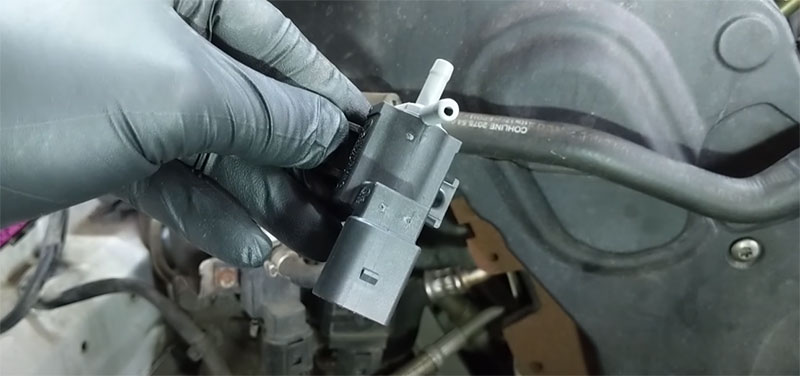
4.4 Post-Replacement Check
After installing the new valve:
-
Double-check hose routing — incorrect connections can cause overboost or turbo damage.
-
Clear the DTCs using your scan tool.
-
Perform a functional test using live data (via VCDS, ODIS, or compatible tools):
-
Monitor turbo pressure regulation during boost.
-
Watch for N75 duty cycle response (usually expressed as % PWM).
-
4.5 Test Drive & Monitor Behavior
Take the vehicle on a test drive under load:
-
Accelerate moderately to high RPMs in a safe environment.
-
Observe boost levels, engine responsiveness, and whether DTC P0243 returns.
If the issue persists even with a new N75, further diagnosis may be needed — including ECU output checks, wiring continuity, or wastegate actuator inspection (see Step 5).
Step 5: Clear Fault Codes and Perform Road Test
Once the suspected issue—such as a faulty N75 valve or compromised vacuum lines—has been addressed, it’s essential to validate the repair through code clearing and a thorough road test. Here’s how to do it effectively:
5.1. Use a Diagnostic Tool to Clear Stored Fault Codes
-
Connect your OBD-II diagnostic scanner (such as VCDS, OBDeleven, or Launch X431) to the vehicle’s diagnostic port.
-
Navigate to the engine control module (ECM) and locate the stored fault code P0243.
-
Use the “Clear DTCs” or “Erase Fault Codes” function to reset all stored codes.
-
Confirm that no active or pending codes remain after the reset.
5.2. Monitor Live Data During the Road Test
-
Before starting the drive, select and monitor key live data parameters, such as:
-
Turbo Boost Pressure (Actual vs. Specified)
-
N75 Duty Cycle (%)
-
Wastegate control behavior
-
-
These values can provide real-time insights into whether the turbocharger control system is operating correctly under load.
5.3. Conduct a Controlled Road Test
-
Drive the vehicle on a safe open road where you can simulate different driving conditions:
-
Idle and city driving: Observe system response at low RPMs.
-
Acceleration under load: Accelerate through multiple gears and watch for boost response and solenoid activation.
-
Cruising and deceleration: Confirm stable operation without triggering fault codes.
-
-
If the turbocharger builds boost properly and there are no driveability issues, it suggests the system is functioning as intended.
5.4. Perform a Final Scan
-
After the road test, re-scan the vehicle using your diagnostic tool.
-
Check if DTC P0243 or any other turbo-related fault codes have returned.
-
If no codes are present and boost data aligns with expected values, the repair can be considered successful.
5.5. Optional: Long-Term Monitoring
-
For peace of mind, especially in performance vehicles, consider monitoring turbocharger performance over the next few days.
-
Some advanced tools allow for logging live data during extended drives for further analysis.
5. How Much Does Fixing Audi P0243 Error Cost?
The total cost to fix the Audi P0243 fault code can vary significantly depending on the exact cause, your Audi model, labor rates in your area, and whether you use OEM or aftermarket parts. Here’s a breakdown of typical costs associated with resolving this issue:
5.1. Diagnostic Fee
-
Cost: $80 – $150
Most repair shops charge a diagnostic fee to scan the fault codes and identify the problem. If you have an OBD2 scanner or diagnostic tool like OBDeleven, you can do this step yourself.
5.2. N75 Valve Replacement (Boost Pressure Control Solenoid)
-
Part Cost:
-
OEM or high-quality aftermarket: $40 – $120
-
-
Labor Cost:
-
0.5 to 1 hour: $50 – $120 depending on the shop rate
-
-
Total: $90 – $240
Replacing the N75 valve is the most common fix for a P0243 code. It’s a relatively quick and straightforward job.
5.3. Vacuum Line Repair or Replacement
-
Parts: $10 – $50 (rubber hoses, connectors)
-
Labor: $50 – $100
-
Total: $60 – $150
If cracked or disconnected vacuum lines are found, the repair is inexpensive but essential for turbo control.
5.4. Turbo Wastegate Actuator Repair or Replacement
-
Parts:
-
Manual actuators: $100 – $250
-
Electronic actuators: $300 – $600
-
-
Labor: $200 – $500 depending on accessibility
-
Total: $300 – $1,100
A failing or stuck wastegate actuator can also trigger P0243. This is a more expensive and labor-intensive repair.
5.5. Wiring or ECU Issue
-
Repair cost: $100 – $600+
If the root cause is electrical—such as a shorted wire or faulty ECU output to the N75 valve—troubleshooting and repair can be more complex and expensive.
Average Repair Cost Range
-
DIY with basic tools: As low as $40–$120 (if you’re just replacing the N75 valve)
-
Professional shop repair: Typically between $150–$600
-
High-end repairs involving turbo or actuator: $800–$1,200+
Tips to Save Money
-
Use trusted aftermarket parts when OEM isn’t necessary.
-
Consider DIY repairs for easy tasks like valve replacement or hose checks.
-
Get a second opinion if a shop recommends turbocharger replacement right away.
-
Use a quality diagnostic scan tool to pinpoint the real issue before buying any parts.
6. Tips for Preventing Future Issues
Preventing the recurrence of DTC P0243 in your Audi involves more than just replacing faulty parts—it requires regular maintenance, system awareness, and proactive checks. Below are practical and expert-backed tips to keep your turbocharger boost control system healthy and avoid triggering this code again:
6.1. Perform Regular Turbocharger System Inspections
-
Visually check vacuum lines for cracks, leaks, or wear every 10,000–15,000 km (or every oil change).
-
Inspect electrical connectors to the N75 valve for signs of corrosion, loose pins, or moisture intrusion.
-
Look for oil contamination around the turbo, N75 valve, and hoses, as it may indicate underlying seal or PCV issues.
6.2. Keep the N75 Valve Clean and Functional
-
The N75 valve can get clogged with carbon, oil mist, or dirt over time.
-
Periodically remove and clean the N75 valve with electronic parts cleaner or compressed air to prevent sticking or inconsistent boost control.
-
Avoid using poor-quality aftermarket replacements; OEM or high-quality OE-spec parts ensure better reliability.
6.3. Avoid Aggressive Driving on a Cold Engine
-
Always let the engine warm up before pushing the throttle hard.
-
Turbo systems rely on oil pressure and proper temperature; aggressive acceleration on a cold engine increases stress on the N75 valve and wastegate system.
6.4. Use High-Quality Engine Oil and Replace It Regularly
-
Use the oil grade recommended by Audi (usually VW 502 00 or VW 504 00 spec oils).
-
Dirty or degraded oil can cause carbon buildup in the turbo system and affect vacuum control.
-
Change the oil on time—even earlier than the factory interval if you drive under severe conditions.
6.5. Ensure Proper Software and ECU Updates
-
Sometimes, a software calibration issue or outdated ECU firmware can cause improper boost control signals or incorrect fault detection.
-
Check with your Audi dealer or qualified VAG specialist if any ECU updates or TSBs (Technical Service Bulletins) are available for your model.
6.6. Use a Boost Gauge or OBD Monitor for Early Detection
-
Install an aftermarket boost gauge or use a tool like OBDeleven to monitor boost pressure and N75 duty cycle regularly.
-
Detecting boost spikes, drops, or erratic N75 behavior early can prevent full-blown failures and stored fault codes.
6.7. Don’t Ignore Minor Boost-Related Symptoms
-
If you notice sluggish acceleration, poor throttle response, or hear unusual turbo noises, don’t wait for the check engine light.
-
These can be early signs of a failing N75 valve, sticky wastegate, or vacuum leak—even if no DTC is currently active.
Need Help Fixing Audi P0243? Let AutoExplain Handle It!
Still unsure what’s causing the P0243 fault on your Audi? Don’t waste time guessing or replacing parts blindly.
At AutoExplain, we offer remote diagnostic support, ECU coding, and technical guidance from experienced automotive experts—all online. Whether you’re a DIYer or a professional, our team can help you identify the root cause fast and walk you through the correct fix with the right tools and software.
✅ Remote ECU diagnostics & coding
✅ Step-by-step technical support
✅ Expert advice tailored to your Audi model
✅ No need to tow your car or visit a workshop
👉 Get professional support now at AutoExplain.com and fix your car with confidence!
Let’s solve it together—smarter, faster, better.


How to Perform 7 Speed DSG Basic Settings with ODIS on Skoda Octavia
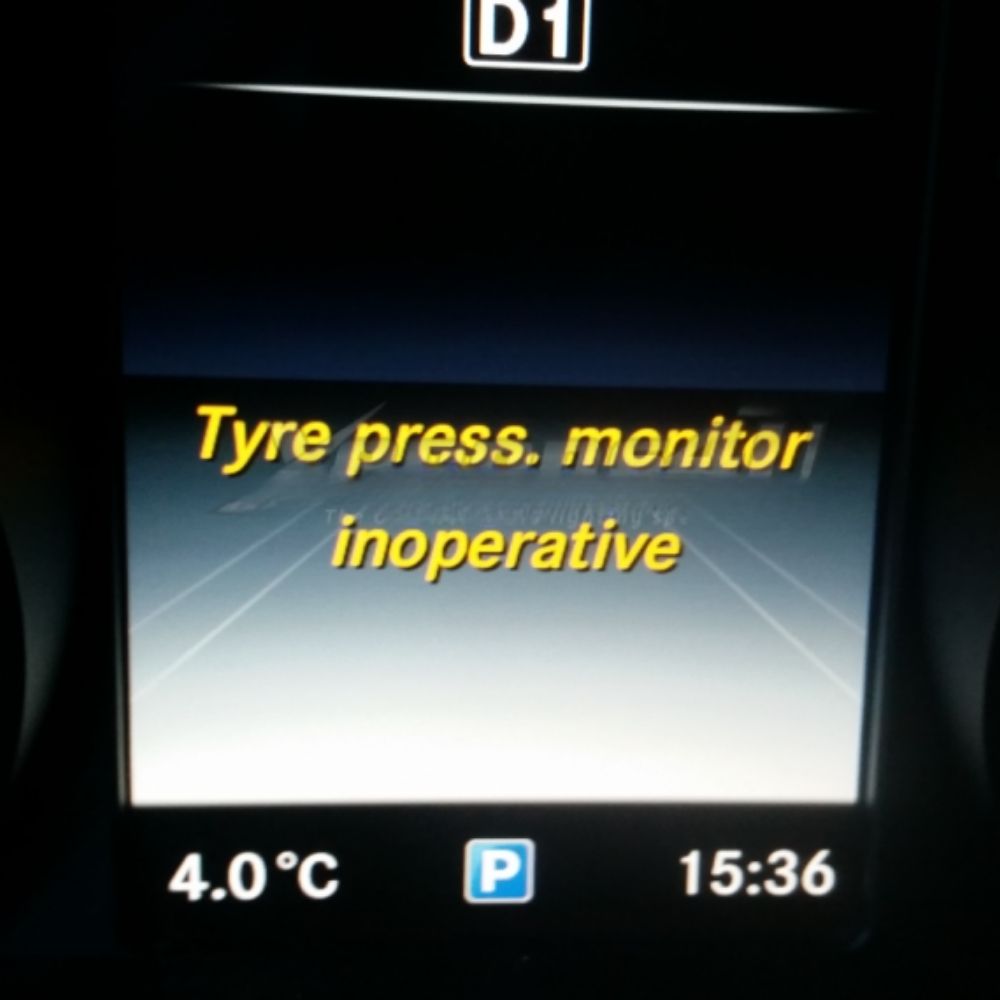
How do you fix a Tire Pressure Monitor Inoperative Mercedes





